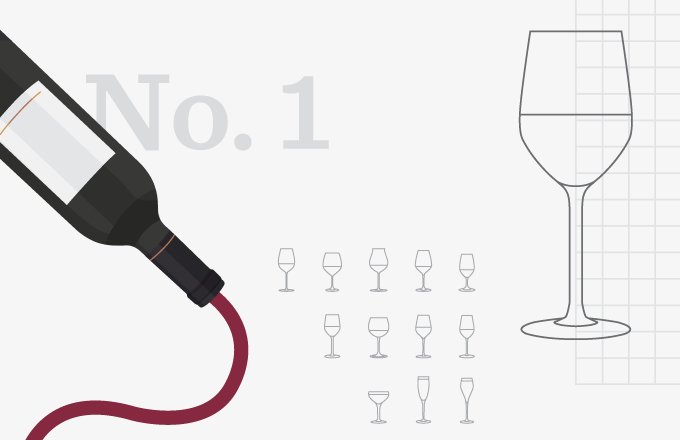


According to some professionals, even if you expertly uncork a wine bottle and perfectly pour a glass, if you’re using the wrong glassware, you’re limiting a drink’s potential. Over the years, glassware has evolved to enhance each individual type of drink and improve the overall drinking experience.
In addition to expert opinion, scientific studies have found a correlation between glass shape and a drink’s presentation, flavor, aroma, body, temperature, and even the way people drink it.
There are hundreds of different glass types so you may be thinking, “How can I possibly stock every option and memorize every single pairing?”
Don’t worry, we’re here to help! Check out the list below to see what glassware experts suggest using for each beverage. Also, learn more about how to Price your individual types of wine glasses in order to ensure success. BevSpot’s bar inventory app specializes in drink and food and helps you manage a successful business, try and get set up for free today.
Start Your Free Trial With Bevspot Today!
You may know that wine goes in a wine glass. But, do you know why?
A wine glass is made of four basic parts: the rim, bowl, stem, and foot.
The size of the rim and the thinness of the rim’s material can affect the wine’s taste and temperature. The stem allows people to hold their wine glass without transferring heat from their hands, helping to maintain a wine’s intended serving temperature. A wine glass’s bowl helps to capture and spread a wine’s aroma and the foot allows the drink to stand upright.
If you’ve got the basics down, you’re in good shape. However, although their main parts are similar, not all wine glasses are exactly the same. If you’re looking to provide customers with a top-notch experience, the type of wine you’re serving should dictate which specific type of wine glass to use.
When you’re serving a nice red, you should use a larger wine glass with a full, round bowl and a large opening. A red wine glass should have a large surface area to give the wine more contact with the air and allow for more flavor and aroma to release. It also provides a customer with enough space to dip his or her nose into the glass to get a good whiff!
If you want to go a step further than a simple red wine glass, you can stock your bar with Bordeaux, Burgundy, Merlot, Pinot Noir, Shiraz, and/orPort glasses.
The Bordeaux glass is designed for heavy, full-bodied wines and its bowl is smaller than a standard red wine glass. To maximize the flavor, the glass is taller, so the wine proceeds directly to the back of the mouth. You can use this glass for syrah, cabernet sauvignon, merlot, and other rich, strong wines.
The Burgundy glass is designed for lighter, full-bodied wines like Pinot Noir. This glass is shorter than the Bordeaux glass but it has a bigger bowl so the wine is directed to the tip of the tongue so the drinker can taste the more delicate flavors.
The Pinot Noir glass also has a tapered lip and a wide bowl, but the stem is shorter compared to other red wine glasses.
The Shiraz glass stands out from other wine glasses because it’s significantly tapered inwards, it has a wide base and bowl, and it has a mid-sized stem. These features are supposed to first present fruit aromas, followed by the tannin flavors.
The Port glass features a small, slim bowl and a shorter stem. The smaller bowl size makes it so the strong smells don’t overwhelm the pepper, black currant, and oak flavors. The glass is designed with a short stem, so the drinker’s hand warms the wine as he or she sips, helping to enhance the flavor.
The bowl of a white wine glass is more vertical, has more of a “U” shape, and a generally smaller mouth area than a red wine glass. Because it is usually served cold, this glass shape allows white wine to maintain a cooler temperature while still allowing aromas to be released. The wine also aerates less so it retains more delicate and lighter notes.
Like red wine glasses, there are a variety of white wine glasses. If you want to stock your bar with a variety of white wine glasses, consider using Montrachet, Sauvignon Blanc, and/or Riesling glasses.
As a side note, keep in mind younger white wine is usually best served in a white wine glass with a slightly bigger opening so the wine is directed to the tip and the sides of the tongue to accentuate its sweetness. More mature white wines are usually best served in taller and straighter glasses so the wine is dispensed to the back and the sides of the tongue in order to taste the bolder flavors.
The white wine glass described above is also referred to as a Chardonnay glass, which is sometimes considered the “all-purpose” white wine glass because it is versatile and appropriate for any dry, light wine such as Pinot Grigio.
The Montrachet glass is used to improve Montrachet Chardonnay. The glass has a larger bowl so the drinker can better smell the complex aromas. It also has a wider rim to direct the wine to the edges of the tongue, so the wine’s sour and acidic flavors are accentuated.
Another white wine glass is the Sauvignon Blanc glass. This type of glass is designed for more fruity white wines. This glass is tall and it has a slender bowl to help focus the floral and fruit aromas. Its narrow mouth helps deliver the aroma straight to the nose and spotlight the front of the tongue. In addition to Sauvignon Blanc, this glass can also be used for wines like White Bordeaux or Loire.
The Riesling glass is smaller, taller and narrower than a typical Chardonnay glass. This helps to keep the fruity aroma at the top of the wine glass and it directs the wine to the back of the mouth, so the drinker isn’t overwhelmed with sweetness.
Sparkling wine (Asti, Cava, Champagne, Prosecco) should be served in an upright glass that is narrower than an average wine glass in order to maintain the carbonation and flavor. Depending on the type of sparkling wine you serve and your customer’s personal preference, you may want to stock Coupes, Champagne Flutes, and Champagne Tulips.
The oldest type of champagne glass is called the Coupe or the Saucer. This glass was most popular during the roaring 20s and it has a stylish, wide, and shallow bowl. Although it is often used for its vintage look, this style of glass is not as popular as it once was because it is not able to capture the qualities of today’s champagne. Due to its shallow bowl, the bubbles and the aromas dissipate quickly.
Both classic and classy, the Champagne Flute is a popular choice for serving sparkling wine. Contrary to the Coupe, due to its design, the Champagne Flute successfully delivers fizz to the senses. The glass features a rough bead at the base,which causes the carbon dioxide bubbles to congregate and rapidly rise. This type of glass is great for younger wines. However, it may limit the complex flavors and aromas of older wines.
The Champagne Tulip is similar to the Flute, but it has a larger bowl space. It gets its name because it’s shaped like a tulip flower with a slim base opening into a wide bowl and narrowing slightly towards the aperture. Much like the flute, this design allows for lots of bubbles, but because the Tulip has a larger aperture it helps the bubbles hit the right regions of the tongue instead of going up a drinker’s nose. This larger opening also allows for more aeration and thus more flavors and aromas.
Schedule 15mins to chat with a product specialist
Start a FREE Trial Today! BevSpot offers full product education and account setup for all customers! No card Information needed!
For more info on drink pricing, bar inventory, management techniques, and kitchen inventory, stay tuned to the BevSpot blog. You’ll get notifications when we post new articles, as well as exclusive access to our industry tools and guides.
